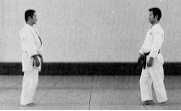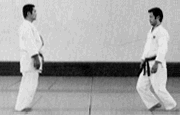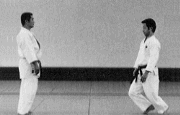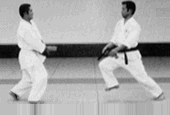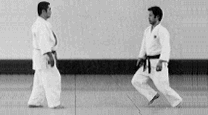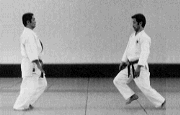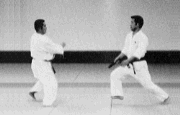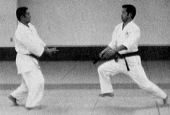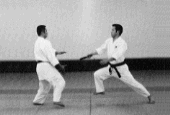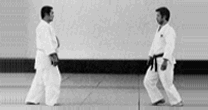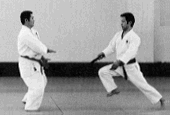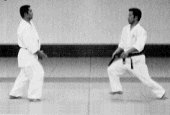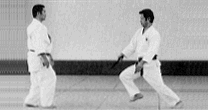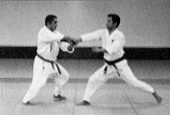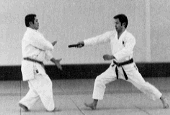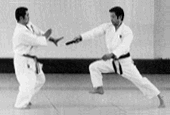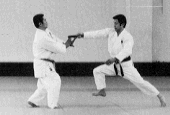|
1. Shomen Ate. |
5. Ushiro Ate. |
3. Gyaku-gamae
Ate. |
6. Oshi Taoshi. |
|
17. Hiki
Otoshi. |
2. Ai-gamae
Ate. |
4. Gedan Ate. |
7. Ude Gaeshi. |
|
14. Tenkai Kote
Gaeshi. |
16. Sumi
Otoshi. |
8. Hiki Taoshi. |
11. Kote
Hineri. |
|
15. Mae Otoshi. |
13. Tenkai Kote
Hineri. |
9. Ude Hineri. |
12. Kote
Gaeshi. |
|
|
|
|
10. Waki
Gatame. |
|
|
Atemi Waza - The "Striking" Techniques |
|
|
1. Shomen Ate. |
1. Shomen Ate. The "Forward Strike." So called because the defender steps
diagonally forward and offline, and then presses forward against the
attacker's neck, breaking his balance and hurling him into a back fall. Note
that to avoid being skeweblack, one must side step the knife. The defender
does put a hand up to the attacker's wrist, but that is not to block away the
strike, merely to keep the knife at bay while performing the technique
against the head. Note also that though translated as a "strike",
this technique is not a punch. One pushes against and does not strike the
head. |
|
|
2. Ai-gamae
Ate. |
2. Ai-gamae Ate. The "Matching
Stances Strike." So called because as the defender finishes the
technique, his stance will match that of the attacker. In the video, the
attacker is in a right-foot-forward stance. As Nariyama Sensei finishes the
technique and makes the throw, note that he too ends up in a
right-foot-forward stance. In doing the technique, one side steps the blow,
pulls momentarily on the attacker's arm so that he wants to pull back, and
then, just as he pulls back, surges in to push against the head and throw the
attacker down. |
|
|
3. Gyaku-gamae
Ate. |
3. Gyaku-gamae Ate. The
"Opposing Stances Strike." So called because as the defender
finishes the technique, his forward foot will be opposite that of the
attacker. Notices that as Nariyama Sensei finishes the throw, he ends up in a
left-foot-forward stance, which is opposite the attacker's right-foot-forward
stance. In doing the technique, Nariyama Sensei first side steps the stab,
and then uses his left arm to throw uke, while his right keeps the weapon at
bay. There is no impact to the head. Contact is made smoothly before strong
power is applied for the throw. |
|
|
4. Gedan Ate. |
4. Gedan Ate. The "Low
Strike." So called because the defender goes low, under the attacker's
attacking arm, to throw him. Nariyama Sensei first slides left to avoid the
blow. He grabs the attacker's arm and first attempts to do Gyaku-gamae Ate
(see above) with his left hand. However, the attacker shields himself with
his own left hand, frustrating Gyaku-gamae Ate. So, Nariyama Sensei goes low,
sliding under both of the attacker's upraised arms, and throwing the
attacker. Again, there is no hard impact. Torsos are brought together smoothly
before power is applied. |
|
|
5. Ushiro Ate. |
5. Ushiro Ate. "The
Behind Strike." So called because the defender slides behind the
attacker before throwing the attacker backwards onto his own back. Notice
that Nariyama Sensei slides forwards and to his own left as he avoids the
stab. By applying pressure to the attacker's arm, he uses it as a lever with
which to rotate the attacker's entire upper torso. This provides both
shoulders as points which Nariyama can grab to pull the attacker down.
Pressure is momentarily applied downward through the attacker's back to lock
his legs. He is then thrown backwards. |
|
|
|
Hiji Waza - Elbow Techniques |
|
|
6. Oshi Taoshi. |
6. Oshi Taoshi. "The Pushing Topple." In this technique, Nariyama Sensei
slides back and to the left, avoiding the blow. As he does so, he pulls back
on the attacker's arm. As the attacker pulls back to regain his balance,
Nariyama Sensei sides forward, keeping the attacker's elbow in his own center
and pushing towards the attacker's ear. This forces all of the attacker's
weight onto his back, left foot. At that point, it is an easy matter to push
a little more and knock the attacker over. A gentle elbow lock is used as a
hold down for this demonstration. |
|
|
7. Ude Gaeshi. |
7. Ude Gaeshi. "The Arm
Folding Technique." In this technique, Nariyama Sensei slides to the
left to avoid the stab. As he does so, he grabs the attacker's arm and gives
it a little tug. This causes the attacker to be slightly unbalanced. As the
attacker pulls back with his arm in an attempt to regain his balance,
Nariyama Sense slides forward, bends the attacker's arm at the elbow, and
pulls the attacker backward by folding the arm over, behind the shoulder. The
attacker is thrown onto his back. |
|
|
8. Hiki Taoshi. |
8. Hiki Taoshi. "The
Pulling Topple." In this technique, Nariyama Sensei slides back and to his
left to avoid the strike. As he does so, he blocks at the attacker's wrist
with his right hand, and grabs the attacker's wrist underneath with his left.
In doing so, his left hand is palm side upward. He then pulls back with that
left hand while simultaneously turning the hand over, so that it is now
palm-side downward. Doing so locks the attacker's elbow. The unbalanced
attacker is now brought down by pulling and applying gentle pressure at the
elbow with the right hand. |
|
|
9. Ude Hineri. |
9. Ude Hineri. "The Arm
Twist." This technique is a counter to the previous one. One first
attempts Hiki Taoshi: one grabs the wrist the same and tries to break the
attacker's balance. If however, the attacker's balance is not fully broken,
and he is pulling back, you go with it. As you can see Nariyama Sensei
demonstrate, one steps to the outside, locks the attacker's arm under one's
own, and then throws the attacker forward by twisting one's upper torso. Be
sure not to lift upwards on the attacker's arm, as doing so will rip the
shoulder out. Simply twisting while keeping the attacker's arm level will
throw the attacker quite well. |
|
|
10. Waki
Gatame. |
10. Waki Gatame. "The Side
Pin." The Japanese name for the technique refers to an arm bar applied
while the defender is standing to the attacker's side. Nariyama Sensei first
avoids the stab by sliding to the side. He simultaneously raises the
attacker's arm using a hand blade. He grabs the attacker's arm and initially
pulls him upward, breaking his balance. The attacker's arm is then brought
down and snugly placed in the crook of the right elbow for the pin. Key to
the technique is grabbing and rotating the attacker's forearm so as to lock
out the elbow joint. Watch Nariyama's left hand accomplish this trick. |
|
|
|
Tekubi Waza - The Wrist Techniques |
|
|
11. Kote
Hineri. |
11. Kote Hineri. "The Wrist
Twist." This technique is very similar to Oshi Taoshi. Nariyama Sensei
first slides back and to the left to avoid the stab. As he does so, he uses
his right hand to grab the attacker's stabbing hand. He twists the hand up
and counter clockwise (if in Nariyama's place and looking down at the wrist.)
Doing so locks out the wrist joint and forces the attacker's arm to twist.
With a little more pressure, and help from his left hand, Nariyama causes
this twist to carry on to the attacker's torso. The attacker is easily pushed
down, with the wrist lock being maintained all the way down to the ground. |
|
|
12. Kote
Gaeshi. |
12. Kote Gaeshi. "The Wrist
Fold." As demonstrated here, this is a counter to the previous
technique, Kote Hineri. Nariyama Sensei slides back and to the left to avoid
the stab. He grabs the attacker's wrist and tries to twist it up and counter
clockwise, as above. However, the attacker successfully resists this attempt
by twisting his own wrist (viewed from his own position) clockwise. Doing so,
however, leaves him open to Kote Gaeshi. Nariyama Sensei moves to his right,
pulling the attacker off balance, and then continues that clockwise (from the
attacker's point of view!) turning of the wrist. This thoroughly breaks the
attacker's balance and throws him into a forward flyer fall. Notice that as
done here, Kote Gaeshi is not a pain submission wrist hold. It is a balance
breaking technique as execute here in this version of the technique. |
|
|
13. Tenkai Kote
Hineri. |
13. Tenkai Kote Hineri. "The
Rotating Wrist Twist." In the name of this technique, the Tenkai or
rotating part refers to the defender's having to turn 180 degrees while
executing the technique. The hineri or twist part describes what is done to
the attacker's kote or wrist. Nariyama Sensei avoids the stab by sliding
forward and to his left. As he does so, he grabs the stabbing arm with both
hands, slips in next to the attacker's torso, and then, keeping the
attacker's arm on his own center line, rotates 180 degrees to his left. Doing
so twists the wrist and locks up the wrist and elbow joints. Nariyama then
lifts the attacker's arm upward to get him on his toes. Nariyama then slides
back and to his right as he yanks the attacker's locked arm downward. The
attacker is simultaneously pulled down and to the right, and is thrown to the
ground. |
|
|
14. Tenkai Kote
Gaeshi. |
14. Tenkai Kote Gaeshi. "The
Rotating Wrist Fold." Again, the tenkai or rotating part of this
technique's name refers to the fact that the defender has to turn around
while executing the technique. The gaeshi or folding part of the name
describes what is done to the attacker's wrist. This technique is also
commonly referblack to as Shiho Nage, which means "The Four Direction
Throw," a name also meant to describe the fact that the defender has to
turn around (through 4 directions). Nariyama Sensei slides forward and to the
right to avoid the stab. He grabs the attacker's arm, and twists it to break
the attacker's balance. Then, keeping the arm in his own center, he turns
around. As he does so, his right hand folds the attacker's wrist back towards
the attacker's forearm. Pressure is applied forward and down for the throw. |
|
|
|
Uki Waza - The Floating Techniques |
|
|
15. Mae Otoshi. |
15. Mae Otoshi. "The
Forward Drop." This technique begins the same as the previous one,
Tenkai Kote Gaeshi. Nariyama Sensei slides to the right and grabs the
attacker's arm with both hands. He then tries to raise the attacker's arm up so
as to get under it and do Tenkai Kote Gaeshi. The attacker, however, locks
the elbow joint and frustrates the attempt. That however, allows Nariyama
Sensei to slide his left arm up and under the attacker's locked arm. Nariyama
then gently levers down on that arm, breaking the attacker's balance upward.
It is then just a matter of stepping forward with the back left leg to
provide the impetus to throw the attacker. |
|
|
16. Sumi
Otoshi. |
16 Sumi Otoshi. "The
Corner Drop." To understand the name of the technique, imagine that Nariyama
Sensei is in a rectangular room. At the end of the technique, he ends up
throwing the attacker towards (from Nariyama's starting position facing a
wall) the front right corner of the room. Nariyama slides to the front and
right to avoid the stab. He grabs the attacker firmly with both arms, pulls
the attacker's arm down and to the left to break his balance, and then gets
the force to throw the attacker by stepping forward with the left foot and
bending his knees, thus sinking his weight. The attacker's arm is kept in
Nariyama's center throughout for maximum control. |
|
|
17. Hiki
Otoshi. |
17 Hiki Otoshi. "The
Pulling Drop." This is very similar to Judo's Ippon Seioi Nage, except
that it is done just by manipulating the attacker's arm. Nariyama Sensei
slides forward and to the right to avoid the stab. As he does so he grabs the
attacker's wrist with his left hand. The right hand reaches under the
attacker's arm and grabs just above the elbow. Nariyama next pulls down
toward the floor the attacker's arm, while also simultaneously pulling
towards his own belly the attacker's elbow. This twisting motion applied to
the elbow is what breaks the attacker's balance sufficiently to throw him.
Nariyama bends at the knees to sink his weight to throw the attacker. |
|
